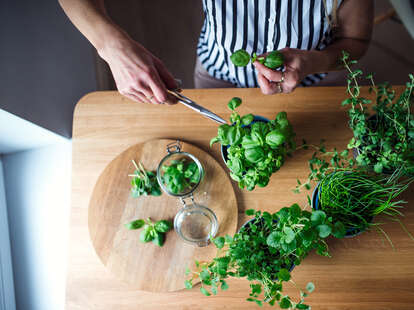What Are the Easiest Herbs to Grow Inside?
When to harvest and what to cook with tarragon, thyme, and all your favorites.
There are so many upsides to growing your own herbs—their lovely aroma and deep flavors as well as the gorgeous greenery on your windowsill that is bound to brighten up your home are just a few. However, with so many of us living in cold cities and dark spaces that are the opposite of sun-soaked, it can make growing at home a little difficult.
Seema Prasad, avid cook and proprietor of sustainable restaurant Miel in Nashville, has been passionately growing herbs for over four decades, starting from planting basil with her grandmother when she was a child to dedicating an entire back window in her house to an indoor garden.
“If we can grow stuff, why not?” says Prasad, whose restaurant is known for its onsite garden and seasonally driven menu. “When you cook with herbs you’ve grown and picked yourself, it feels like you’re connecting with your food more. You smell it on your hands for hours.”
The best herbs to grow inside
When it comes to growing herbs indoors, Prasad strongly recommends fines herbes, which consist of parsley, chives, tarragon, and chervil. They are less susceptible to major weather changes, so they will flourish year-round if properly taken care of.
“A lot of it is finding a window with the right light,” Prasad says. “These delicate herbs are more sensitive. If you have the sun baking down on them, they’ll dehydrate in six hours, so I’ll find a window with a lot of ambient light and not direct light, or a filtered light.”
The best herbs for each season
In terms of seasonality, Prasad embraces the different herbs that come with the changes in weather, since certain herbs tend to pair well with the foods that are also in season alongside them. “Every season has herbs that do the best, so when it comes to growing, you work with the seasons,” she says.
In the winter, Prasad says to go for your heartier, more woodsy herbs, like rosemary and thyme, while summer is the time to embrace basil and cilantro. She particularly enjoys herbs that flourish in the spring, like marjoram and oregano. Her favorite, however, tends to grow well in late spring as well as late summer in the shade.
“One of my favorite herbs, and you don’t see it often, is summer savory. It’s halfway between cayenne and rosemary, and it’s kind of peppery,” says Prasad. “I chop it up really fine and toss it with little halved cherry tomatoes and olive oil.”
When to harvest your herbs
Harvesting your herbs varies from plant to plant—they all grow at different rates depending on their conditions. For all herbs, however, Prasad recommends consistently trimming them regularly with sharp scissors to promote growth and to make sure to harvest them before they begin to flower, as this is when their flavor is the strongest.
“They will keep growing if you keep clipping them back, so use your herbs,” Prasad says. “They will reward you many times over.”

What to cook with your fresh herbs
According to Prasad, there are two main ways to use herbs—you can throw them into dishes at the beginning of the cooking process and remove them once the flavor is infused, like bay leaves. You can chop them and use them fresh, whether you are tossing them into a salad or using them as a garnish. Regardless of which herb you use, they are bound to completely alter your dish.
“I love boiling tiny potatoes, roasting them in a pan with some browned butter and tossing them with fresh, chopped tarragon,” Prasad says. “My friends go crazy over it and ask for the recipe, and I’m like, there is no recipe. It’s potatoes, butter, and tarragon. But it’s the herbs that make it what it is.”
While her menu changes daily, Prasad showcases herbs as much as possible at Miel, from the Miyagi oysters covered in lemon-herb-garlic butter and marinated olives tossed in fresh thyme to the gin and tonics garnished with an orange-coriander rim. Prasad likes to get innovative with her herbs, candying them, making simple syrups, and chopping them up and putting them on the rim of a cocktail.
“That’s the cool thing about herbs—they add dimension to your food,” she says. “When you learn how to use herbs, the flavors become so much more complex and interesting.”
How to store your fresh herbs
One of Prasad’s favorite things about growing her own herbs is that she gets to choose how much she picks from her garden, as opposed to store-bought plastic containers that have a set amount and don’t promote freshness in their storage. When she picks too much from her plants, however, she makes sure to properly store them.
“I really like to store herbs in water, like they are still living,” she says. “I will often either do that or I will dampen a paper towel and wrap around that, and maybe stick the stem of that in water so it’ll last longer in the fridge.”
